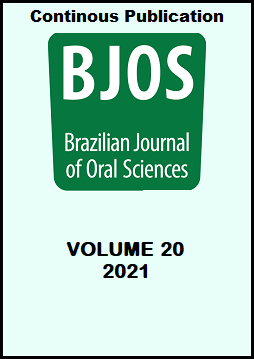Abstract
Aim: this study aimed to compare the sealing ability of two types of commercially available calcium silicate bioceramic based root canal sealers and a resin based root canal sealer. Methods: Twenty one single-rooted teeth were used, samples (n= 21) were randomly divided into three groups according to the sealer used (group A; ADSEAL, group B; Wellroot, group C; Ceraseal). Roots were then cleaved longitudinally in the labiolingual direction; all samples were then sectioned at three, six, and nine mm from the root tip. The penetration of sealers into the dentinal tubules was examined at 1000x with a scanning electron microscope. Data were tested for normality using Shapiro Wilk test. ANOVA test was used for analyzing normally distributed data followed by Bonferroni post hoc test for pair-wise comparison. Significance level p≤0.001. Results: groups B and C showed better sealing ability than group A in all the three sections. The coronal section showed higher sealing ability than the middle section followed by the apical section in the three tested groups. Conclusion: it can be concluded that both calcium silicate-based sealers had better sealing ability and higher bond strength than the resin epoxy- based sealer.
References
Al-Haddad A, Che Ab Aziz ZA. Bioceramic-based root canal sealers: a review. Int J Biomater. 2016;2016:9753210. doi: 10.1155/2016/9753210.
Reszka P, Nowicka A, Lipski M, Dura W, Droździk A, Woźniak K. A comparative chemical study of calcium silicate-containing and epoxy resin-based root canal sealers. Biomed Res Int. 2016;2016:9808432. doi: 10.1155/2016/9808432.
Wang Y, Liu S, Dong Y. In vitro study of dentinal tubule penetration and filling quality of bioceramic sealer. PLoS One. 2018 Feb 1;13(2):e0192248. doi: 10.1371/journal.pone.0192248.
Ha JH, Kim HC, Kim YK, Kwon TY. An Evaluation of Wetting and Adhesion of Three Bioceramic Root Canal Sealers to Intraradicular Human Dentin. Materials (Basel). 2018 Jul;11(8):1286. doi: 10.3390/ma11081286.
Abdul Khader M. An in vitro scanning electron microscopy study to evaluate the dentinal tubular penetration depth of three root canal sealers. J Int. Oral Health. 2016;8(2):191-4.
Gad RA, Farag AM, El-Hediny HA, Darrag AM. Sealing ability and obturation quality of root canals filled with gutta-percha and two different sealers. Tanta Dent. J. 2016;13(4):165-70. doi: 10.4103/1687-8574.195703.
Huang Y, Orhan K, Celikten B, Orhan AI, Tufenkci P, Sevimay S. Evaluation of the sealing ability of different root canal sealers: a combined SEM and micro-CT study. J Appl Oral Sci. 2018 Jan;26:e20160584. doi: 10.1590/1678-7757-2016-0584.
Kim HJ, Baek SH, Bae KS. Sealing ability of root canals obturated with gutta-percha, epoxy resin-based sealer, and dentin adhesives. J Korean Acad Conserv Dent. 2004;29(1):51-7. doi: 10.5395/JKACD.2004.29.1.051.
Vemisetty H, Ravichandra PV, Reddy S J, Ramkiran D, Krishna M JN, Sayini R, et al. Comparative evaluation of push-out bond strength of three endodontic sealers with and without amoxicillin-an invitro study. J Clin Diagn Res. 2014 Jan;8(1):228-31. doi: 10.7860/JCDR/2014/7180.3919.
Kapasi A, Bishnoi A, Meena SS, Singh P, Patodia A. Sealability of bioceramic cements on root ends prepared using a hard tissue LASER evaluated by stereomicroscope - an in vitro study. Acta Scient Dent Sci. 2018;2(8):9-18.
Toursavadkohi S, Zameni F, Afkar M. Comparison of tubular penetration of AH26, EasySeal, and Sure-Seal root canal sealers in single-rooted teeth using scanning electron microscopy. J Res Dent Maxillofac Sci. 2018;3(3):27-32. doi: 10.29252/jrdms.3.3.27.
Gyulbenkiyan E, Gusiyska A, Vassileva R, Dyulgerova E. Scanning electron microscopic evaluation of the sealer/dentine interface of two sealers using two protocols of irrigation. J IMAB. 2020;26(1):2887-91. doi: 10.5272/jimab.2020261.2887.
Baruah K, Mirdha N, Gill B, Bishnoi N, Gupta T, Baruah Q. comparative study of the effect on apical sealability with different levels of remaining gutta-percha in teeth prepared to receive posts: an in vitro study. Contemp Clin Dent. 2018 Sep;9(Suppl 2):S261-5. doi: 10.4103/ccd.ccd_196_18.
Abdelrahman MH, Hassan MY. Comparison of root canals walls cleanliness filled with two different calcium silicate bioceramic based sealers and a resin-based sealer after retreatment. Int. J Dentistry Res. 2020;5(1):20-3.
Vujasković M, Teodorović N. Analysis of sealing ability of root canal sealers using scanning electronic microscopy technique. Srp Arh Celok Lek. 2010 Nov-Dec;138(11-12):694-8. doi: 10.2298/sarh1012694v.
Eid BM, Waly AS, Princy P, Venkatesan R. Scanning electron microscope evaluation of dentinal tubules penetration of three different root canal sealers. EC Dent. Sci. 2019;18(6):1121-7.

This work is licensed under a Creative Commons Attribution 4.0 International License.
Copyright (c) 2021 Brazilian Journal of Oral Sciences


